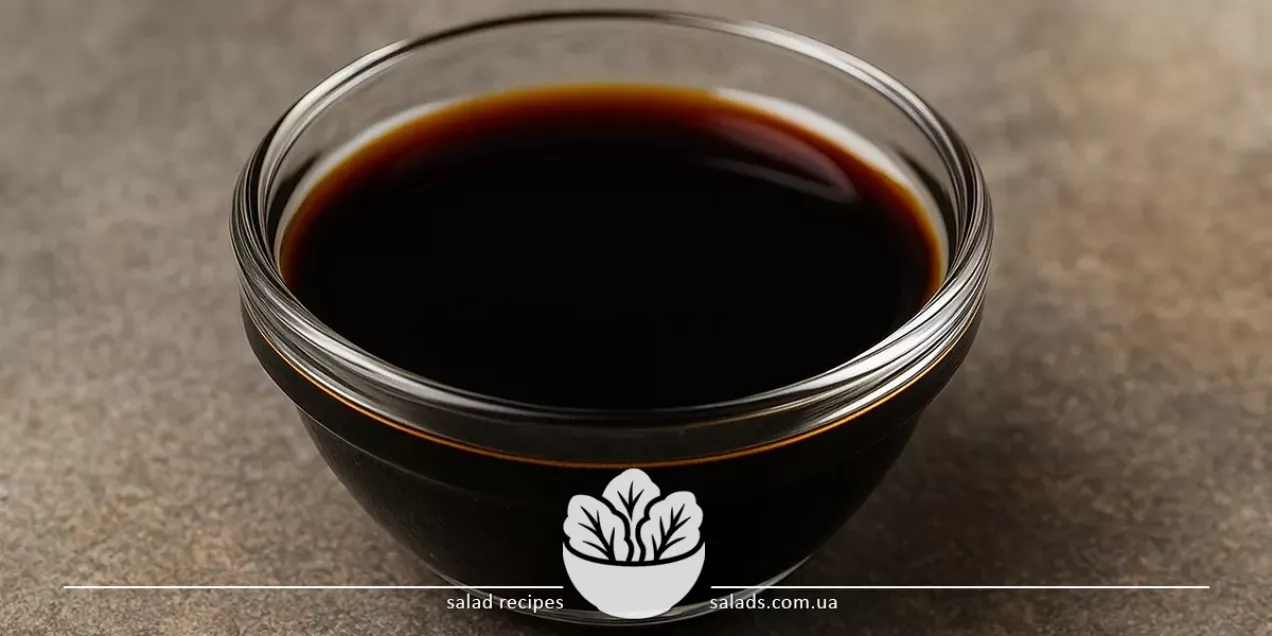
Soy Sauce

Soy sauce is a traditional Asian sauce obtained by fermenting soybeans along with wheat, salt, and water. It has a dark brown color, a rich umami flavor, and a distinct salty aroma. Soy sauce is used as a seasoning for meat, fish, vegetables, and rice and serves as a base for preparing marinades and dressings. Its popularity has spread far beyond Asia, and it has become an essential component of many world cuisines. Learn more about sauces in the sauces section.
Salad Recipes with Soy Sauce
Classic Recipes with Soy Sauce
Soy sauce is one of the most popular seasonings used in various dishes and culinary traditions. It is ideal for marinating meat, such as chicken fillet, which becomes tender and flavorful. Soy sauce is often added to vegetable salads with avocado and canned green peas, enhancing their flavor and aroma. In many dishes, crab sticks paired with soy sauce are used in salads, appetizers, and sushi. This sauce is also widely used in preparing sauces and dressings, where it blends well with tomatoes, creating a perfect balance of saltiness and acidity. It is added to marinades to intensify the natural taste of ingredients without overpowering their texture and aroma. Soy sauce is also used in hot dishes, particularly in Asian soups, rice, and noodle dishes. Its rich umami flavor gives depth and balance to any dish. Thanks to its versatility and strong taste, soy sauce remains an essential ingredient in the culinary traditions of many cultures worldwide.
Soy Sauce in Global Cuisine
Soy sauce is a key seasoning in Asian cuisines such as Japanese, Chinese, Korean, and Vietnamese. In Japan, it is indispensable for making sushi, sashimi, miso soups, and various marinades. Chinese cuisine uses it in meat, vegetable, and noodle dishes, adding a rich umami flavor. In Korea, soy sauce is a primary ingredient in many barbecue sauces, soups, and tofu dishes. Vietnamese recipes include soy sauce in numerous marinades and salads, known for their freshness and bold flavor. Additionally, soy sauce has gained popularity in European countries, where it is used to prepare Asian dishes and in modern fusion cuisine. With its intensity, saltiness, and deep umami taste, soy sauce has become a global culinary phenomenon, widely used in international kitchens, expanding the possibilities for flavor combinations and culinary experiments.
Choosing and Evaluating Soy Sauce Quality
When choosing soy sauce, it is important to consider its ingredients, production method, and country of origin. Natural soy sauce is produced by fermenting soybeans and wheat, ensuring a rich flavor, aroma, and beneficial properties. This type of sauce has a dark brown color, thick consistency, and pronounced umami aroma. There are also chemically produced sauces that contain fewer natural ingredients and have a sharper, saltier taste. It is best to choose fermented sauces with minimal additives and no artificial colorings or preservatives. The country of origin plays an important role: Japanese, Korean, and Chinese sauces each have their own unique taste and texture. It is also important to check the expiration date and storage conditions to maintain the product’s quality until use. A high-quality soy sauce is the foundation for preparing many tasty and balanced dishes.
Preparation and Use of Soy Sauce
Soy sauce is made by naturally fermenting soybeans, wheat, salt, and water, a process that lasts from several months to several years. This fermentation creates a deep, complex flavor with salty and umami notes. Some manufacturers use accelerated methods, which affect the intensity of the aroma, but traditional fermented soy sauce is considered higher quality. In cooking, soy sauce is used as a salad dressing, marinade for meat, fish, and vegetables, and as an addition to rice, noodles, and soups. It is often used in Asian dishes where flavor balance is crucial. Soy sauce is also combined with other sauces such as wasabi, ginger, sesame oil, or garlic. Due to its versatility, soy sauce is widely used in various culinary traditions—from classic Japanese and Chinese recipes to modern fusion cuisine. Its strong aroma and taste can transform ordinary meals into true culinary masterpieces.
Storing Soy Sauce and Using Leftovers
Soy sauce, especially naturally fermented, should be stored in a cool, dark place away from direct sunlight. An opened bottle should be kept in the refrigerator to maintain its flavor and extend its shelf life for several months. Industrial sauces often contain preservatives, allowing them to be stored at room temperature, but to ensure the best quality, it is advisable to follow the manufacturer’s recommendations. Soy sauce leftovers can be used for marinades, dressing preparation, sauces, and to add rich flavor to soups, stews, and stir-fried dishes. Proper storage and use of soy sauce help reduce food waste and preserve the product’s aroma and intensity of flavor.